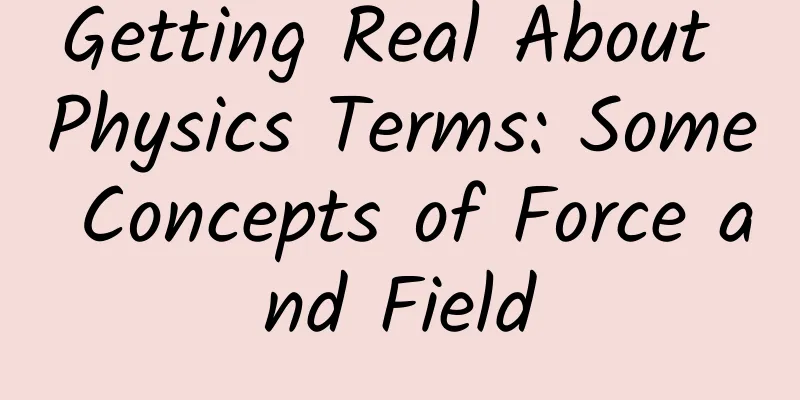Getting Real About Physics Terms: Some Concepts of Force and Field

|
Opening remarks Analytical philosophy, an important branch of 20th century philosophy, places the study of language at the center of philosophy. Wittgenstein, a representative of analytical philosophy, pointed out that philosophy is the result of incorrect use of everyday language. This error is not in the propositions of the argument and their logical relationships, but in the language used in the argument. In physics, the use of language is equally important. In scientific research, scientists create proper nouns to name new natural phenomena or new scientific concepts. Good names can help people understand the meaning of the words. Complex phenomena and difficult concepts will be remembered by people because of intuitive and easy-to-understand names. Some scientific terms are fascinating and arouse people's curiosity and desire to explore. If the names are not good, people may misunderstand or be discouraged. When creating proper nouns, one principle is to reveal the essence of things or point out their most important characteristics. When new things first appear, scientists name them based on their understanding at the time. However, as science continues to develop, in some cases, the initial understanding may not be correct, and the nouns used are prone to misinterpretation. But since the noun has been widely used, it is not easy to change it. This situation is common in the history of science. Modern science originated in the West, and most scientific terms first appeared in Western languages. When translating into Chinese, it is important to be accurate and fluent. There are only two methods of translation: free translation and transliteration. Most scientific terms in Chinese are translated free of charge. Let's take a few examples from physics. Electron literally means a charged particle, or more precisely, a basic particle with a unit negative charge. Neutron is an electrically neutral particle in the nucleus. Proton means a particle that concentrates most of the mass of the nucleus, but in fact, the masses of neutrons and protons in the nucleus are very close. Transliterated nouns are not very intuitive in meaning, but they have an advantage, which is that they can avoid unnecessary "literal interpretation". Some concepts contain complex meanings and are difficult to summarize with a simple word. Transliteration is more effective. For example, quark is the transliteration of the English word Quark. Quarks are the basic particles that make up nucleons (i.e. neutrons and protons). The original meaning of quark in English is the cry of a seagull. Physicist Gell-Mann got inspiration from literary works and named it. According to the way of literal translation, some Chinese physicists call quarks "layers", and they have also been translated as "deficiencies" in Taiwan, but these translated names have not been widely used. The author will "choose words and phrases" on some important terms in physics, carefully study their meanings, and explore the profound physical meanings behind them. Think carefully and distinguish them clearly. Some terms are particularly well named and accurately reflect the essence or characteristics of things. Some terms, due to historical reasons, have deviated from their essence and are easy to be misunderstood. This article first discusses several terms related to force and field. --author Written by Chen Shaohao (Massachusetts Institute of Technology, USA) Mechanics is not necessarily about force Mechanics is the most important branch of physics. With the development of physics, the content of mechanics is constantly updated and changed. In modern physics, some subjects named mechanics have nothing to do with force. The word Mechanics comes from Greek, and originally meant things related to machinery or machines. Later, its meaning gradually evolved into a study of the nature of mechanical motion of objects. The derived word Mechanism refers to mechanism. In the 17th century, Newton proposed the three famous laws of motion, and the mechanics based on Newton's three laws was later called Classical Mechanics. It is worth noting that Newton hardly used the word Mechanics in his famous work "Mathematical Principles of Natural Philosophy". Classical mechanics mainly studies the force, momentum, energy, and the relationship between objects. For example, Newton's second law states that the external force on an object is equal to the product of its inertial mass and acceleration. In classical mechanics, force is the core concept, and the force on an object is the main factor that determines its movement, so it is reasonable to translate Mechanics into mechanics. In the 18th century, mathematicians developed analytical mechanics, which re-described classical mechanics in a more basic mathematical form. Newton's laws were expressed in equivalent mathematical forms - Lagrange's equations and Hamilton's equations. In analytical mechanics, force is no longer an important concept, and the central physical quantity is energy. In the 20th century, after the advent of quantum mechanics, the concept of force was completely abandoned. Quantum mechanics does not have the force in classical mechanics at all, but retains concepts such as mass, energy, and momentum. The word Mechanics in English has no direct connection with the word Force in terms of meaning, and many disciplines named Mechanics in modern physics no longer have the concept of force. So the question is, should Mechanics still be translated into mechanics? Since the meaning of Mechanics has undergone many historical changes, it is not easy to find a Chinese word that accurately expresses all its meanings. Using the word "mechanics" that people are used to is a good choice. Let's look at another example. Kinetics is a branch of classical mechanics, which refers to the study of the causes of motion, especially the relationship between motion and force. The Chinese translation is dynamics. In many modern English documents and textbooks, the word Kinetics has been replaced by another word Dynamics. Dynamics studies the changes of physical systems over time and the reasons behind it. In Chinese documents, Dynamics is still translated as dynamics. For example, Electrodynamics, the study of the laws of how electromagnetic fields change over time, is translated as electrodynamics. In modern physics, the causes of the evolution of physical systems have no direct relationship with force, so the author believes that it is worth discussing whether Dynamics should be translated as dynamics. Gravity is not a force Not only does quantum mechanics have nothing to do with force, but another great achievement of 20th century physics, general relativity, points out that gravity is not a force. In the history of physics, the meaning of gravity has evolved several times. The word gravity comes from the Latin word Gravitas, which means weight. Its original meaning refers to the gravity of objects on the earth. Later, Newton discovered that the gravity of objects on the earth and the mutual attraction between celestial bodies in the universe are the same force, which he called universal gravity. Newton's law of universal gravitation has achieved great success. From the movement of everything on Earth to the movement of celestial bodies in the universe, everything can be well explained and calculated by the law of universal gravitation. However, Newton did not explain how gravity is generated, why gravity is a long-range force, that is, why there is a force between two objects that are not in contact? In the early 20th century, Einstein proposed a new theory of gravity - general relativity. In general relativity, gravity is described as the geometric curvature of space-time, which links the curvature of space-time with the mass and energy of the matter in it. The so-called gravity is not that one object produces a mysterious long-range effect on another distant object, but that the mass of this object causes the curvature of space-time, and the other object is just running along the shortest route in the curved space-time. In a flat space, the shortest route between two points is a straight line. In a curved space, the shortest route between two points is a curved one. It looks like there is an attractive force that deflects the direction of an object's movement, but in fact gravity is not a force, but an effect that causes the curvature of space-time to change the trajectory of an object's movement. Let's take a familiar example - the earth revolves around the sun. According to the explanation of classical mechanics: the gravitational force generated by the sun acts on the earth, causing the earth to revolve around the sun in an elliptical orbit. However, general relativity proposes a completely new explanation: the huge mass of the sun causes the space-time around it to bend, and the earth moves along the shortest route in the curved space-time, which is an elliptical orbit around the sun. Therefore, it is not the distant sun that generates a force acting on the earth. Gravity is not an action at a distance, but an inevitable result of the curvature of space-time. Since gravity is not a force, a more accurate description is "attractive interaction." Gravity is one of the four basic interactions in nature. Figure 1: The huge mass of the Sun causes the space-time around it to bend, and the Earth moves along the shortest route in the curved space-time, which is an elliptical orbit around the Sun. Field is the origin of matter In modern physics, force is no longer at the center, but field has become the most important concept. The first physicist to propose the concept of "field" was Faraday. More than 160 years ago, in the lecture hall of the Department of Physics at Cambridge University, Faraday showed the public the magnetic lines of force around a magnet and proposed the concept of magnetic field for the first time. Faraday used the word "field" because he thought of the fields on the farm at that time. The English word for field is "Field". The field in physics means that each coordinate point in space has a value of a physical quantity, just like sowing seeds in each small pit in the field. The word field is very vivid and has been used by physicists to this day. At the end of the 19th century, Maxwell proposed a unified theory to describe the electromagnetic field, which closely linked electricity and magnetism. A changing magnetic field generates an electric field, and a changing electric field generates a magnetic field. The energy of the electromagnetic field propagates in space in the form of waves, thus predicting the existence of electromagnetic waves. Electromagnetic waves were confirmed by Hertz's experiment. From then on, physicists were convinced that the electromagnetic field was real, and the concept of field became the paradigm of modern physics. In the early 20th century, Einstein established the theory of general relativity, which revealed the intrinsic connection between time, space and gravity, interpreted the gravitational field as the curvature of space-time itself, and predicted the existence of gravitational waves. Gravitational waves refer to ripples in the curvature of space-time, which propagate outward from the source of gravity in the form of waves. One hundred years later, the LIGO Observatory confirmed the existence of gravitational waves in the universe. In the mid-to-late 20th century, physicists developed quantum field theory from quantum mechanics. Quantum field theory believes that each elementary particle corresponds to a quantum field, and elementary particles are produced by the excitation of quantum fields. In other words, all matter and interactions (except gravity) originate from quantum fields. Quantum fields are quantized, and energy is in pieces. The smallest unit of energy, called a quantum, is the elementary particle observed in the laboratory. For example, photons that propagate electromagnetic interactions are quanta of the electromagnetic field, and electromagnetic fields are excited to produce photons. Similarly, gluons that propagate strong interactions are quanta of the gluon field. Not limited to elementary particles that propagate interactions, all elementary particles that constitute matter are also produced by the excitation of quantum fields. For example, the electron field is excited to produce electrons, the quark field is excited to produce quarks, and so on. The vacuum isn't really empty Finally, let’s look at an example where a noun itself cannot reflect a physical fact – vacuum. Vacuum refers to a state of space where no matter exists. However, according to quantum field theory, the existence of field excludes absolute vacuum. Even if all matter in space is removed, quantum field still exists. Because quantum field fluctuates, there is still tiny energy in space, energy and matter are equivalent, so there is no absolute vacuum in nature. The vacuum state should be regarded as the ground state of matter, that is, the state with the lowest energy, but the energy is not zero. About the Author Shaohao Chen holds a bachelor's degree in physics and a doctorate in atomic and molecular physics from Tsinghua University. He was a postdoctoral researcher at the University of Colorado Boulder, and has worked at Louisiana State University and Boston University. He is currently working at the Massachusetts Institute of Technology, engaged in high-performance computing. This article is supported by the Science Popularization China Starry Sky Project Produced by: China Association for Science and Technology Department of Science Popularization Producer: China Science and Technology Press Co., Ltd., Beijing Zhongke Xinghe Culture Media Co., Ltd. Special Tips 1. Go to the "Featured Column" at the bottom of the menu of the "Fanpu" WeChat public account to read a series of popular science articles on different topics. 2. Fanpu provides a function to search articles by month. Follow the official account and reply with the four-digit year + month, such as "1903", to get the article index for March 2019, and so on. Copyright statement: Personal forwarding is welcome. Any form of media or organization is not allowed to reprint or excerpt without authorization. For reprint authorization, please contact the backstage of the "Fanpu" WeChat public account. |
>>: China Petroleum Memorial Day | Why is oil so precious? Will it be replaceable in the future?
Recommend
Will the small-screen, low-priced iPhone be a nightmare for low-end Android phones?
Not long ago, rumors about Apple launching a 4-in...
Things to note when bidding for multiple websites at the same time! How to bid for ranking?
The site group strategy of SEM strategy is differ...
Paul Dirac: You'll Never Walk Alone
Dirac is a unique figure in the history of scienc...
Which is more expensive, fur or mink? The difference between the two
Fur and mink are two types of fur fabrics that we...
Analysis of the underlying logic of the user incentive system!
Background of the User Incentive System The user ...
Zhangye Binggou Danxia: Desolate and lonely beauty
Danxia is a red landform first discovered and nam...
Wang Daheng: Founder of New China's Optical Industry | Childhood of the Hero of "Two Bombs and One Satellite"
Wang Daheng, the founder of New China's optic...
The rise and fall of parallel-imported iPhone 6: Hong Kong version worth 20,000 yuan is out of stock
With the release of the new generation of iPhones...
Contagious! Rare disease breaks out in the country, over 80 people infected
According to Indian media reports on the 12th, an...
[Popular Science of Chinese Military Technology] Why is it said that the reliability of ChatGPT in military applications needs to be verified?
The full name of GPT is (Generative Pre-trained T...
Amazing photo: Polar bear "eats whale"!
A simple meal is hard to come by for polar bears ...
Easy custom camera
Source code introduction This is a simple custom ...
Before I even took off my shoes, I could smell the stink of feet...
There is an embarrassment called foot odor. Espec...
Behind the strong push of TVOS operating system by radio and television: facing resistance from Android
Imagine if everyone’s brain had the same configur...
Revelation of JD.com’s 618 marketing promotion!
Whenever "618" comes, consumers find it...









